Applied Mathematics and Mechanics (English Edition) ›› 2024, Vol. 45 ›› Issue (12): 2131-2146.doi: https://doi.org/10.1007/s10483-024-3201-8
• Articles • Previous Articles Next Articles
Shiping JIANG1, Xiujing HAN2,*( ), Hailong YU3
), Hailong YU3
Received:2024-08-15
Online:2024-12-01
Published:2024-11-30
Contact:
Xiujing HAN
E-mail:xjhan@ujs.edu.cn
Supported by:2010 MSC Number:
Shiping JIANG, Xiujing HAN, Hailong YU. Mixed-mode fast-slow oscillations in the frequency switching Duffing system with a 1:n frequency ratio. Applied Mathematics and Mechanics (English Edition), 2024, 45(12): 2131-2146.

Fig. 1
Two examples of the oscillation patterns showing sliding motions[23]. Simulations of the system (1) with the frequency ratio $ n=2 $ for different values of the frequency-switching threshold $ a $. (a) $ a=0.7 $; (b) $ a=0.4 $. The other parameters are fixed at $ \delta=0.5 $, $ \beta=0.5 $, and $ \omega=0.01 $ (color online)"


Fig. 2
Generation of mixed-mode fast-slow oscillations in the system (1) with $ a=0.7 $ for different values of $ n $. (a) $ n=3 $; (b) $ n=11 $; (c) $ n=19 $; (d) $ n=27 $. The other parameters are the same as in Fig. 1. The red numbers 1, 3, 5, and 7 mean the numbers of large-amplitude oscillations of relaxational type. Here, the oscillation pattern in Fig. 1(a) for the case $ n=2 $, denoted by the red dashed curve, is overlaid (color online)"
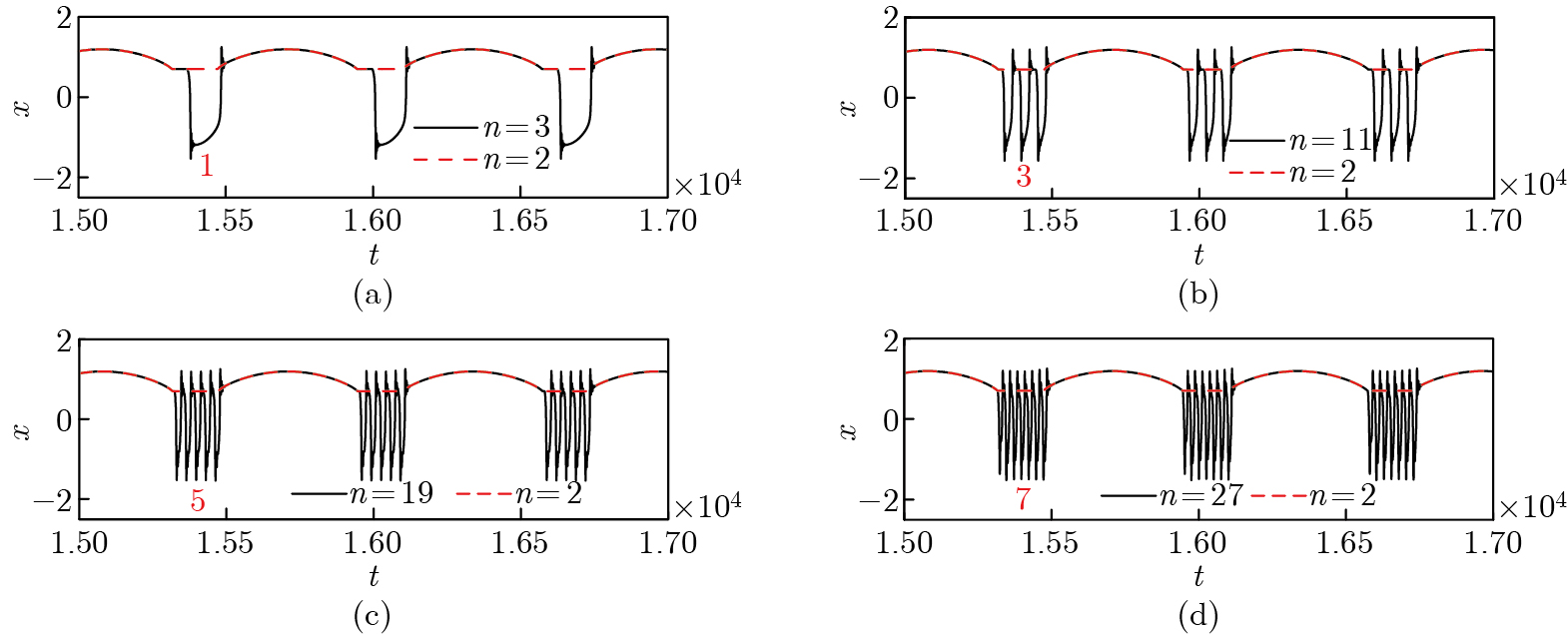
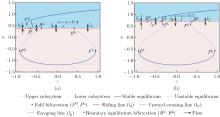
Fig. 3
Bifurcation behaviors of the system (3) with respect to $ \gamma $ for different values of $ a $[23]. (a) $ a=0.4 $; (b) $ a=0.7 $. The other parameters are the same as in Fig. 1. Sliding line (escaping line): both of the neighboring vector fields point towards (depart from) the boundary; upward crossing line: both of the neighboring vector fields show flows with the upward direction. Throughout this paper, the superscript characters U and L in the symbols (e.g., $ B^{\rm U} $ and $ F^{\rm L} $) mean something related to the upper and lower subsystems, respectively (color online)"

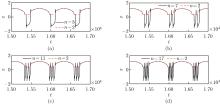
Fig. 4
Typical fast-slow oscillation patterns for the case $ 0<a<a_{\rm c} $. (a) $ n=3 $; (b) $ n=7 $; (c) $ n=11 $; (d) $ n=17 $. Here, $ a=0.4 $, and $ \delta $, $ \beta $, and $ \omega $ are the same as in Fig. 2. The red dashed curve is the oscillation pattern for $ n=2 $ in Fig. 1(b) (color online)"


Fig. 5
Typical one-parameter bifurcation behaviors of the two subsystems in a whole range of $ x $ with respect to $ \gamma $. (a) The case related to the upper subsystem (5a); (b) and (c) the cases related to the lower subsystem (5b) for different values of $ n $, i.e., (b) $ n=3 $ and (c) $ n=7 $. In (a)–(c), the system parameters are the same as in Fig. 2 (color online)"


Fig. 6
Fast-slow analysis of the oscillation pattern in Fig. 2(a) (i.e., the case when $ n=3 $). (a) Overlay of the transformed phase diagram of the oscillation pattern in Fig. 2(a) with the bifurcation behaviors of the system (5) with respect to $ \gamma $; (b) the local enlargement of (a). Here, the equilibrium branches are highlighted with thick green curves (color online)"
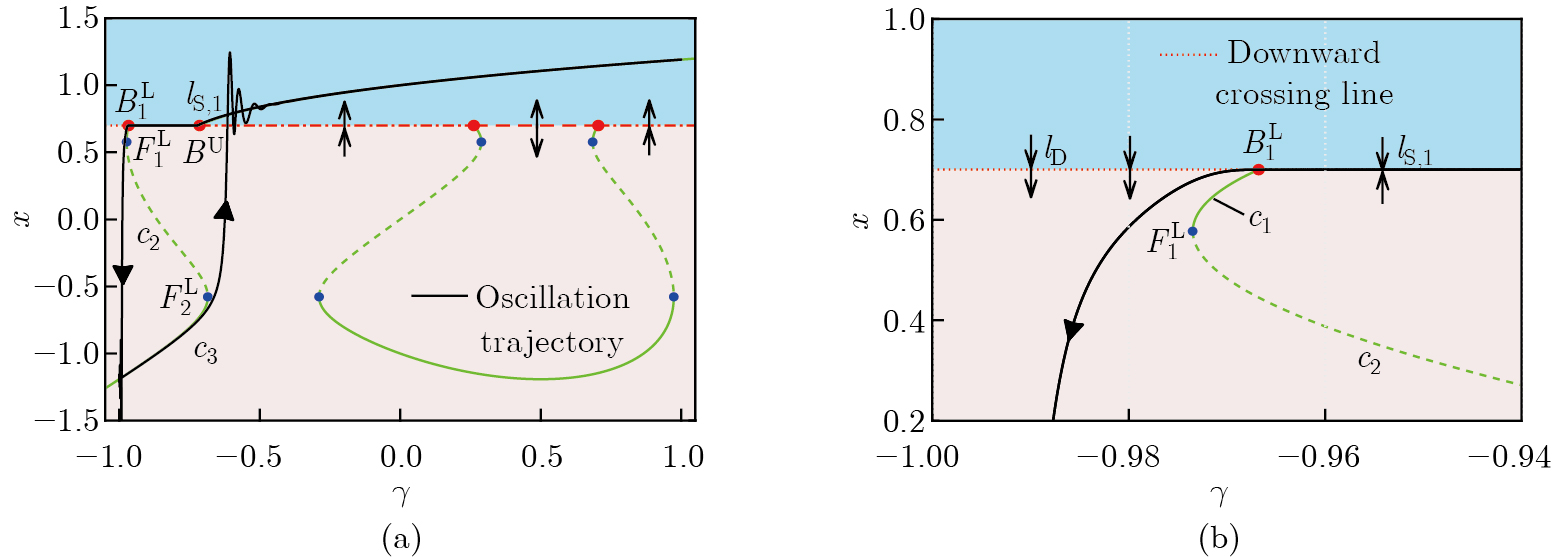

Fig. 12
Fast-slow analysis of the oscillation pattern in Fig. 4(c), i.e., the case when $ a=0.4 $ and $ n=11 $. (a) Bifurcation diagram of the system (5) with respect to $ \gamma $; (b) overlay of the bifurcation diagram in (a) with the transformed phase diagram of the oscillation pattern in Fig. 4(c). Here, only the bifurcations and transition properties associated with the generation of the clusters are presented (color online)"
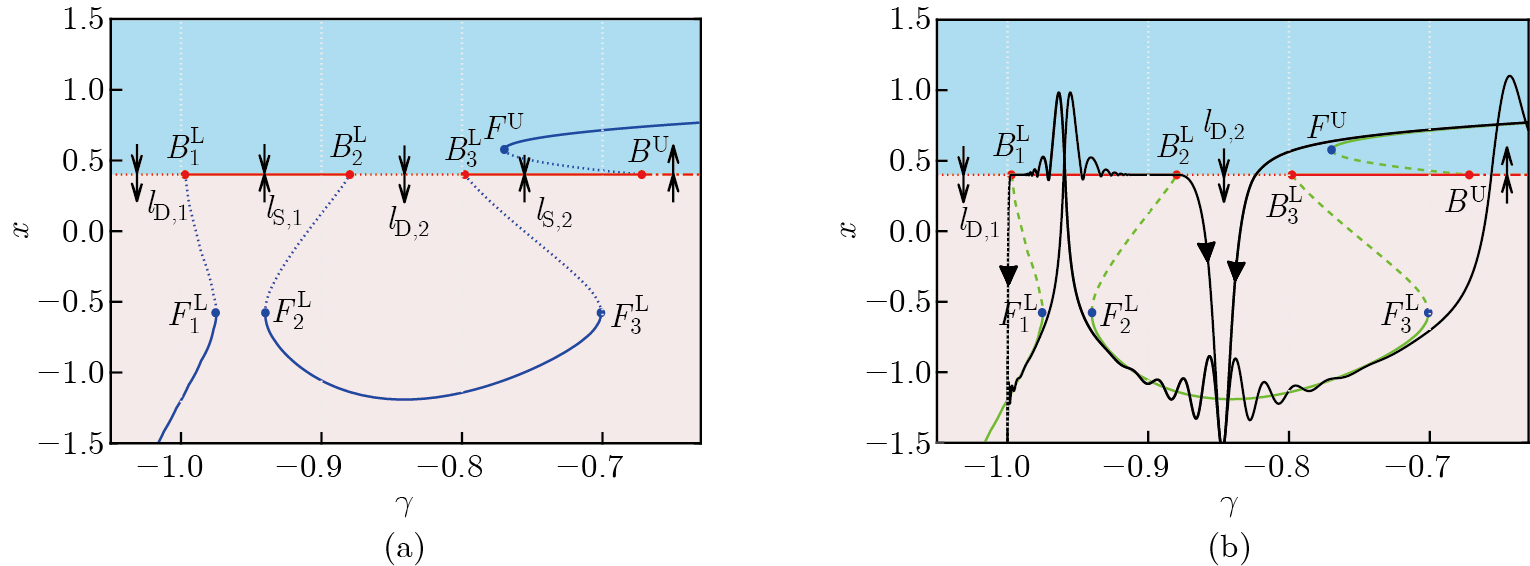
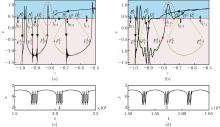
Fig. 13
Mixed-mode fast-slow oscillations for different values of $ \omega $ showing different dynamical characteristics. (a) and (c) the case related to $ \omega=0.002 $, showing four large-amplitude oscillations in the clusters; (b) and (d) the case related to $ \omega=0.015 $, exhibiting three large-amplitude oscillations in the clusters. Here, the stability and bifurcation behaviors shown in (a) and (b) are identical (color online)"

| 1 |
DING, H., and JI, J. C. Vibration control of fluid-conveying pipes: a state-of-the-art review. Applied Mathematics and Mechanics (English Edition), 44 (9), 1423- 1456 (2023)
doi: 10.1007/s10483-023-3023-9 |
| 2 | SHCHERBA, V. E. Preliminary crankshaft speed assessment for a reciprocating hybrid power machine with regenerative heat transfer in compressor and pump modes. Russian Engineering Research, 43 (5), 529- 533 (2023) |
| 3 |
DAI, H. L., HE, Y. X., ZHOU, K., PENG, Z. R., WANG, L., and HAGEDORN, P. Utilization of nonlinear vibrations of soft pipe conveying fluid for driving underwater bio-inspired robot. Applied Mathematics and Mechanics (English Edition), 43 (7), 1109- 1124 (2022)
doi: 10.1007/s10483-022-2866-7 |
| 4 | WU, X. P., CHEN, C. Z., ZHANG, D. C., SUN, X. M., SONG, Y., and YANG, F. Numerical simulation and experimental study of noise reduction of bladeless fan based on acoustic metamaterials. Acoustics Australia, 52 (1), 57- 67 (2024) |
| 5 | KARPOV, I. V., and BOBARIKA, I. O. Analysis of the outlet lattice of the air conditioning system of a modern maneuverable aircraft. Russian Aeronautics, 66, 731- 740 (2023) |
| 6 | ZHANG, B. J., ZHANG, T. A., DOU, Z. H., and ZHANG, D. L. Effect of vortex stirring on the dilution of copper slag. Journal of Wuhan University of Technology-Materials Science Edition, 37 (4), 699- 706 (2022) |
| 7 | TAMURA, A., FUJITA, T., and TAKEUCHI, A. Selective powder feeding system in additive manufacturing using laser-induced forward transfer technique. Additive Manufacturing, 46, 102226 (2021) |
| 8 | ZHUIKOV, A. V., MATYUSHENKO, A. I., PANFILOV, V. I., and NASTEVICH, O. E. Experience of using synthetic gas as the main fuel in an industrial heating boiler house. Power Technology and Engineering, 55, 92- 95 (2021) |
| 9 | ABUBAKR, H., VASQUEZ, J. C., MOHAMED, T. H., and GUERRERO, J. M. The concept of direct adaptive control for improving voltage and frequency regulation loops in several power system applications. International Journal of Electrical Power and Energy Systems, 140, 108068 (2022) |
| 10 | WANG, Y. L., ELDEEB, H. H., ZHAO, H. S., and MOHAMMED, O. A. Sectional variable frequency and voltage regulation control strategy for energy saving in beam pumping motor systems. IEEE Access, 7 (99), 92456- 92464 (2019) |
| 11 | MOHAN, F., and SASIDHARAN, N. Protection of low voltage DC microgrids: a review. Electric Power Systems Research, 225, 109822 (2023) |
| 12 | XU, F., QIU, P., ZHOU, G. H., NI, X. J., LU, Y., LU, C. Y., and HUANG, X. M. Research on control and protection technology of flexible low-frequency AC transmission project. Energy Reports, 8, 137- 146 (2022) |
| 13 | FU, X. X., ZHANG, X., HAN, F., ZHAN, X. D., and YANG, S. Y. Exploring the influence of switching frequency on the stability in a weak grid: a comprehensive analysis of grid-connected photovoltaic systems. Solar Energy, 278, 112767 (2024) |
| 14 | TANG, Y., WANG, F. J., WANG, C. Y., HONG, Y. P., YAO, Z. F., and TANG, X. L. Low-frequency oscillation characteristics of flow for NACA66 hydrofoil under critical stall condition. Renewable Energy, 172, 983- 997 (2021) |
| 15 |
MU, X. W., DING, Z. S., and CHENG, G. F. Uniformly ultimate boundedness for discontinuous systems with time-delay. Applied Mathematics and Mechanics (English Edition), 32 (9), 1187- 1196 (2011)
doi: 10.1007/s10483-011-1492-9 |
| 16 |
FU, S. H., MENG, X. Y., and LU, Q. S. Stability and boundary equilibrium bifurcations of modified Chua's circuit with smooth degree of 3. Applied Mathematics and Mechanics (English Edition), 36 (12), 1639- 1650 (2015)
doi: 10.1007/s10483-015-2009-6 |
| 17 | JEFFREY, M. R. Hidden Dynamics: The Mathematics of Switches, Decisions and Other Discontinuous Behaviour, Springer Nature, Switzerland (2018) |
| 18 | DI BERNARDO, M., CHAMPNEYS, A. R., BUDD, C. J., and KOWALCZYK, P. Piecewise-Smooth Dynamical Systems: Theory and Applications, Springer, London (2008) |
| 19 | FILIPPOV, A. F. Differential Equations with Discontinuous Righthand Sides, Kluwer Academic Publishers, Dordrecht (1988) |
| 20 | KUZNETSOV, Y. A., RINALDI, S., and GRAGNANI, A. One-parameter bifurcations in planar Filippov systems. International Journal of Bifurcation and Chaos, 13 (8), 2157- 2188 (2003) |
| 21 | MAKARENKOV, Q., and LAMB, J. S. W. Dynamics and bifurcations of nonsmooth systems: a survey. Physica D: Nonlinear Phenomena, 241, 1826- 1844 (2012) |
| 22 | JEFFREY, M. R. The ghosts of departed quantities in switches and transitions. SIAM Review, 60 (1), 116- 136 (2018) |
| 23 | HAN, X. J., and BI, Q. S. Sliding fast-slow dynamics in the slowly forced Duffing system with frequency switching. Chaos, Solitons & Fractals, 169, 113270 (2023) |
| 24 | ZHAO, J. H., and HAN, X. J. Sliding bursting oscillations related to transcritical bifurcation delay in an excited vector field with frequency switching. Chaos, Solitons & Fractals, 175, 114066 (2023) |
| 25 | XIAO, H. F., WANG, R. B., NIU, C. H., LIU, Y., and QIAN, K. R. High Frequency Soft-Switching Transformerless Grid-Connected Inverters, Springer, Singapore (2022) |
| 26 | BOOSS-BAVNBEK, B., CHRISTENSEN, J. H., RICHARDSON, K., and CODINA, O. V. Multiplicity of Time Scales in Complex Systems: Challenges for Sciences and Communication Ⅰ/Ⅱ, Springer Nature, Switzerland (2024) |
| 27 |
WANG, K., ZHOU, J. X., TAN, D. G., LI, Z. Y., LIN, Q. D., and XU, D. L. A brief review of metamaterials for opening low-frequency band gaps. Applied Mathematics and Mechanics (English Edition), 43 (7), 1125- 1144 (2022)
doi: 10.1007/s10483-022-2870-9 |
| 28 |
LI, X. H., TANG, J. H., WANG, Y. L., and SHEN, Y. J. Approximate analytical solution in slow-fast system based on modified multi-scale method. Applied Mathematics and Mechanics (English Edition), 41 (4), 605- 622 (2020)
doi: 10.1007/s10483-020-2598-9 |
| 29 | JIANG, W. A., HAN, X. J., CHEN, L. Q., and BI, Q. S. Bursting vibration-based energy harvesting. Nonlinear Dynamics, 100, 3043- 3060 (2020) |
| 30 | HAN, X. J., and BI, Q. S. Bursting oscillations in Duffing's equation with slowly changing external forcing. Communications in Nonlinear Science and Numerical Simulation, 16, 4146- 4152 (2011) |
| 31 | DUAN, L. X., LU, Q. S., and WANG, Q. Y. Two-parameter bifurcation analysis of firing activities in the Chay neuronal model. Neurocomputing, 72, 341- 351 (2008) |
| 32 | YANG, Z. Q., and LU, Q. S. Different types of bursting in Chay neuronal model. Science in China Series G: Physics, Mechanics & Astronomy, 51, 687- 698 (2008) |
| 33 | RAKARIC, Z., and KOVACIC, I. Mechanical manifestations of bursting oscillations in slowly rotating systems. Mechanical Systems and Signal Processing, 81, 35- 42 (2016) |
| 34 | OSINGA, H. M., SHERMAN, A., and TSANEVA-ATANASOVAC, K. Cross-currents between biology and mathematics: the codimension of pseudo-plateau bursting. Discrete and Continuous Dynamical Systems-Series A, 32, 2853- 2877 (2012) |
| 35 | LI, Z. J., FANG, S. Y., MA, M. L., and WANG, M. J. Bursting oscillations and experimental verification of a Rucklidge system. International Journal of Bifurcation and Chaos, 31, 2130023 (2021) |
| 36 | IZHIKEVICH, E. M. Neural excitability, spiking and bursting. International Journal of Bifurcation and Chaos, 10, 1171- 1266 (2000) |
| 37 | LU, Q. S., GU, H. G., YANG, Z. Q., SHI, X., DUAN, L. X., and ZHENG, Y. H. Dynamics of firing patterns, synchronization and resonances in neuronal electrical activities: experiments and analysis. Acta Mechanica Sinica, 24, 593- 628 (2008) |
| 38 | KUEHN, C. Multiple Time Scale Dynamics, Springer, Berlin (2015) |
| 39 | DESROCHES, M., GUCKENHEIMER, J., KRAUSKOPF, B., KUEHN, C., OSINGA, H. M., and WECHSELBERGER, M. Mixed-mode oscillations with multiple time scales. SIAM Review, 54, 211- 288 (2012) |
| 40 | HAN, X. J., LIU, Y., BI, Q. S., and KURTHS, J. Frequency-truncation fast-slow analysis for parametrically and externally excited systems with two slow incommensurate excitation frequencies. Communications in Nonlinear Science and Numerical Simulation, 72, 16- 25 (2019) |
| 41 | GUCKENHEIMER, J., and HOLMES, P. Nonlinear Oscillations, Dynamical Systems and Bifurcation of Vector Field, Springer, New York (1983) |
| 42 | KOVACIC, I., and BRENNAN, M. J. The Duffing Equation: Nonlinear Oscillators and Their Behaviour, Wiley, West Sussex (2011) |
| [1] | Gui-tian HE;Mao-kang LUO. Dynamic behavior of fractional order Duffing chaotic system and its synchronization via singly active control [J]. Applied Mathematics and Mechanics (English Edition), 2012, 33(5): 567-582. |
| [2] | LOU Jing-jun;HE Qi-wei;ZHU Shi-jian . CHAOS IN THE SOFTENING DUFFING SYSTEM UNDER MULTI-FREQUENCY PERIODIC FORCES [J]. Applied Mathematics and Mechanics (English Edition), 2004, 25(12): 1421-1427. |
| [3] | Bi Qinsheng;Chen Yushu;Wu Zhiqiang . BIFURCATION IN A NONLINEAR DUFFING SYSTEM WITH MULTI-FREQUENCY EXTERNAL PERIODIC FORCES [J]. Applied Mathematics and Mechanics (English Edition), 1998, 19(2): 121-128. |
| [4] | Bi Qinsheng;Chen Yushu;Wu Zhiqiang. LOCAL BIFURCATION ANALYSIS OF STRONGLY NONLINEAR DUFFING SYSTEM [J]. Applied Mathematics and Mechanics (English Edition), 1996, 17(9): 837-845. |
| Viewed | ||||||
|
Full text |
|
|||||
|
Abstract |
|
|||||


 Email Alert
Email Alert RSS
RSS